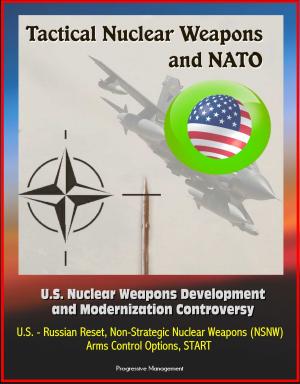The Russian Way of War: Post Soviet Adaptations in the Russian Military and Why the Russian Military Failed in Chechnya - Putin, Grozny, Chechen and Georgian War, South Ossetia, Abkhazia
Nonfiction, History, Military, Strategy, Asian, Russia| Author: | Progressive Management | ISBN: | 9781310129124 |
| Publisher: | Progressive Management | Publication: | October 7, 2014 |
| Imprint: | Smashwords Edition | Language: | English |
| Author: | Progressive Management |
| ISBN: | 9781310129124 |
| Publisher: | Progressive Management |
| Publication: | October 7, 2014 |
| Imprint: | Smashwords Edition |
| Language: | English |
Two interesting studies on the Russian military provide unique and thought-provoking information: The Russian Way of War: Post Soviet Adaptations in the Russian Military and Why the Russian Military Failed in Chechnya.
The Russian Way of War: Post Soviet Adaptations in the Russian Military - Since the collapse of the Soviet Union, the Russian federation has deployed forces for three different large-scale combat operations. These three operations—Chechnya 1994, Chechnya 1999, and Georgia 2008—were conducted facing in each operation, a differently structured opponent. As a result of these different structures, Russian forces were required to conduct both Combat Arms Maneuver and Counter Insurgency. This full spectrum of combat operations provides sufficient material to determine if the military of the Russian Federation has developed a new Russian way of warfare, or if Russian forces are still conducting operations utilizing the same methods as their Soviet predecessors. The determination of a new Russian way of war will be made at the tactical, operational and strategic levels of warfare. As Russia continues to gain wealth from the sale of energy and attempts to expand influence globally, understanding the capabilities and weaknesses of the Russian military will become more important. CHAPTER 1 - INTRODUCTION * Importance and Scope of the Study * Primary and Secondary Research Questions * Soviet Way of War * Doctrine * Manning * Policy * Background: Turmoil of the Post Soviet Army * CHAPTER 2 - FIRST CHECHEN WAR * Prelude to War: Political Maneuvers and Buildup * Russian Threats Prior to Armed Conflict * Russian Military Preparation * Invasion * Fall of Grozny * Initial Attack * Siege and Fall * Russian Counterinsurgency * Aftermath * CHAPTER 3 - SECOND CHECHEN WAR * Prelude to War: de facto Chechen Independence * Russian Reaction to the Conflict in Dagestan * Political Maneuvers * Russian Military Buildup * Military Developments * Russian Invasion * Russian Siege of Grozny * Fall of Grozny * Russian Counterinsurgency * Techniques * Aftermath * CHAPTER 4 - GEORGIAN WAR * Prelude to War * Russian and Georgian Political Maneuvering * Build-up of Forces and Border Skirmishes * Initiation of Hostilities * Georgian Strategy * Russia's Strategy * Ground Forces * South Ossetia Action * Abkhazia Action * Air Force * Operational Challenges * Aftermath * Political * Economic * CHAPTER 5 - SUMMATION OF RUSSIAN STRATEGY * How Russian Forces Developed to fit the Operational Environment * Creation of New Doctrine and TTPs to Meet Operational Needs * Russian Organizational Development * Smaller Force * Conscription * Kontraktniki * Utilization of Soviet Doctrine and TTPs to Meet Operational Needs * Lack of Modernity * Russian Response to a Conventional Threat * Conclusion * A Post-Soviet Way of War?
Why the Russian Military Failed in Chechnya - In this era of peacekeeping, an equally valid argument, however, can be made for the early and preventative use of force. Applying firm and decisive military force prior to the onset of hostilities can often serve to deter the potential aggressor. Crudely expressed, spilling a little blood today may preclude spilling a lot tomorrow. When dealing with those who don't share the same liberal beliefs towards conflict resolution, exhaustive diplomatic maneuverings, sanctions and warnings are interpreted as weakness and lack the persuasive power of a resolute, though limited, use of force. In the first Russian military involvement in Chechnya (October 1994-September 1996), we saw a sloppy mixture of these two approaches. Russian tanks crossed into Chechnya in December 1994 to "establish constitutional order in Chechnya and to preserve the territorial integrity of Russia." This drastic step was the last in a series of increasingly forceful and largely unsuccessful attempts to remove Chechen President Dzhokar Dudayev from power.
Two interesting studies on the Russian military provide unique and thought-provoking information: The Russian Way of War: Post Soviet Adaptations in the Russian Military and Why the Russian Military Failed in Chechnya.
The Russian Way of War: Post Soviet Adaptations in the Russian Military - Since the collapse of the Soviet Union, the Russian federation has deployed forces for three different large-scale combat operations. These three operations—Chechnya 1994, Chechnya 1999, and Georgia 2008—were conducted facing in each operation, a differently structured opponent. As a result of these different structures, Russian forces were required to conduct both Combat Arms Maneuver and Counter Insurgency. This full spectrum of combat operations provides sufficient material to determine if the military of the Russian Federation has developed a new Russian way of warfare, or if Russian forces are still conducting operations utilizing the same methods as their Soviet predecessors. The determination of a new Russian way of war will be made at the tactical, operational and strategic levels of warfare. As Russia continues to gain wealth from the sale of energy and attempts to expand influence globally, understanding the capabilities and weaknesses of the Russian military will become more important. CHAPTER 1 - INTRODUCTION * Importance and Scope of the Study * Primary and Secondary Research Questions * Soviet Way of War * Doctrine * Manning * Policy * Background: Turmoil of the Post Soviet Army * CHAPTER 2 - FIRST CHECHEN WAR * Prelude to War: Political Maneuvers and Buildup * Russian Threats Prior to Armed Conflict * Russian Military Preparation * Invasion * Fall of Grozny * Initial Attack * Siege and Fall * Russian Counterinsurgency * Aftermath * CHAPTER 3 - SECOND CHECHEN WAR * Prelude to War: de facto Chechen Independence * Russian Reaction to the Conflict in Dagestan * Political Maneuvers * Russian Military Buildup * Military Developments * Russian Invasion * Russian Siege of Grozny * Fall of Grozny * Russian Counterinsurgency * Techniques * Aftermath * CHAPTER 4 - GEORGIAN WAR * Prelude to War * Russian and Georgian Political Maneuvering * Build-up of Forces and Border Skirmishes * Initiation of Hostilities * Georgian Strategy * Russia's Strategy * Ground Forces * South Ossetia Action * Abkhazia Action * Air Force * Operational Challenges * Aftermath * Political * Economic * CHAPTER 5 - SUMMATION OF RUSSIAN STRATEGY * How Russian Forces Developed to fit the Operational Environment * Creation of New Doctrine and TTPs to Meet Operational Needs * Russian Organizational Development * Smaller Force * Conscription * Kontraktniki * Utilization of Soviet Doctrine and TTPs to Meet Operational Needs * Lack of Modernity * Russian Response to a Conventional Threat * Conclusion * A Post-Soviet Way of War?
Why the Russian Military Failed in Chechnya - In this era of peacekeeping, an equally valid argument, however, can be made for the early and preventative use of force. Applying firm and decisive military force prior to the onset of hostilities can often serve to deter the potential aggressor. Crudely expressed, spilling a little blood today may preclude spilling a lot tomorrow. When dealing with those who don't share the same liberal beliefs towards conflict resolution, exhaustive diplomatic maneuverings, sanctions and warnings are interpreted as weakness and lack the persuasive power of a resolute, though limited, use of force. In the first Russian military involvement in Chechnya (October 1994-September 1996), we saw a sloppy mixture of these two approaches. Russian tanks crossed into Chechnya in December 1994 to "establish constitutional order in Chechnya and to preserve the territorial integrity of Russia." This drastic step was the last in a series of increasingly forceful and largely unsuccessful attempts to remove Chechen President Dzhokar Dudayev from power.















